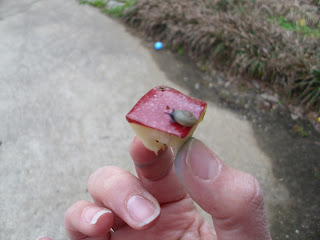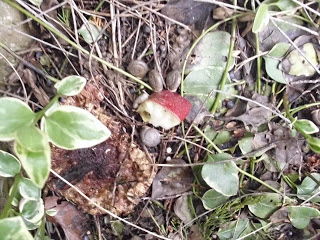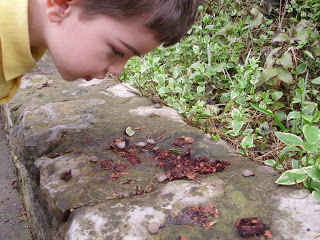Though we’ve always been fascinated with nature, we are starting to use it more as a springboard for science studies and investigations. One of our favorite resources for nature study is Anna Botsford Comstock’s The Big Handbook of Nature Study. At 940 pages, it contains hundreds of lessons and discussion questions about nature. This resource is ALWAYS available for download here at archive.org, though the Erskine family has split it up into 6 different parts for download at their website Homeschool Freebie of the Day (before March 28). This book has been a thorough reference to use as we come across….
well… a multitude of snails, for example.
What’s so fascinating about a snail? Lots! Did you know that:
- The “horns” are stalks for the eyes, and the smaller set of horns are feelers?
- When the snail wishes to withdraw into the shell, the foot (which is the entire lower side of the body) folds itself lengthwise, the head goes in first, and the tail end of the foot goes in last? This animal has an unparalleled ability to stretch itself out and then fold up all of its organs to hide away in its shell.
- As soon as a baby snail hatches, it has a shell with only one spiral turn in it? As it grows, layers of spirals are added on the rim of the opening of the shell.
- Snails winterize themselves? After burying themselves under objects or in soft humus, they make a door of mucus and lime (sometimes three of them) in preparation for the winter, leaving a tiny hole for air to enter…
- Snails eat fruit? They have teeth and a tongue! The next time you see a snail, set some fruit out for him (or her, since snails are both) and watch!
 |
| A young snail on our apple. You can see that there are fewer spirals on this snail’s shell, too! |
 |
| We set out an apple, came back later, and found holes chewed in it, as well as a nice little snail gathering around the apple! |
All of these and many more facts about snails can be found on page 458-461 of The Big Handbook of Nature Study (or in page 153-156 of the Erskine’s Part 4: Insects and Invertebrates). In addition to a thorough description of snails (in story format), a project idea involving the creation of a “snailery” is included, as well as discussion questions/prompts and a nice little poem entitled To a Snail.
The Big Handbook of Nature Study contains the following:
Volume 1: Introduction & Teacher’s Guide
Volume 2: Birds & Fish
Volume 3: Reptiles, Amphibians, and Mammals
Volume 4: Insects & Invertebrates
Volume 5: Trees & Plant Life
Volume 6: Earth, Water & Sky
This resource is available as a free e-book at archive.org! Not only that, but you can also download a free copy of Margaret Williamson’s First Book of Bugs and Albert Tibbets’s First Book of Bees. We used these two books along with The Big Handbook of Nature Study as we learned about Carpenter Bees (See our Bee Battles post.)


